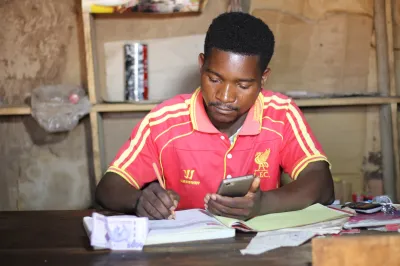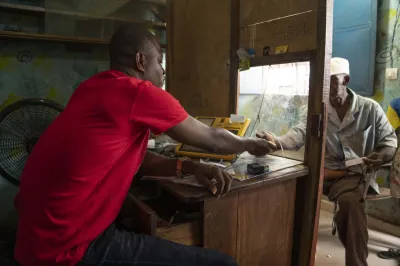G2P Starts with Government to the Poorest in Fiji
This is the fourth post in our series on G2P, branchless banking and financial inclusion. All the other posts can be found here. In this post, our guest bloggers look at the case of the small island country of Fiji. Matt Leonard, formerly with MicroSave, is a consultant documenting the lessons learned from Fiji DSW’s experience. Till Bruett is the Regional Technical Advisor for UNCDF in the Pacific and the Project Manager of the Pacific Financial Inclusion Programme. PFIP is a Pacific-wide programme helping provide sustainable financial services to low income households and is funded by the Australian Agency for International Development (AusAID), UNCDF, the European Union, and the UNDP’s Pacific Centre. More information can be found at www.pfip.org.
On a warm day in the first week of May, hundreds of rural Fijian social welfare recipients traveled from Fiji’s remote, interior highlands to attend what was for many an initiation to branchless banking. The recipients assembled near a small shop in the village of Vunidawa to be introduced to the new concepts by Westpac staff equipped with red bank cards and wireless point-of-sale (POS) devices. Throughout the morning they showed their new clients how to check balances and cash out benefits. Meanwhile the busy local shopkeepers rang up record numbers of receipts through electronic sales.
Since January 2011, Westpac Banking Corporation of Australia has been helping in the distribution of social welfare benefits across Fiji through its network of branches, ATMs and POS devices in their merchant network. In the process, they have also provided access to flexible, no-fee accounts to a previously unbanked population including those living in hard-to-reach areas.
The benefits consist primarily of an unconditional cash transfer averaging about US$37/month for those classified as widows, elderly, disabled, single parents or those with chronic illness. A smaller group of beneficiaries receive a semi-conditional cash transfer for taking care of orphaned, abused or neglected children.
Up until January 2011, it was a common occurrence in Fiji to see long queues of social welfare recipients suffering under a hot sun outside post offices or district social welfare offices across the country. Not only would many of the 24,000+ recipients trek many hours from the poorly connected interior each month to pick up or encash their vouchers, but many might spend FJ$ 10-20 (US$6 – $12), or 15-30% of their modest allowance on travel. It was on one of these days in January 2009 when the Pacific Financial Inclusion Programme (PFIP) decided this was an opportunity to extend the financial access frontier in Fiji – putting in motion the first major G2P project for the poor in the Pacific.
In early 2009, PFIP found a willing ally in an overwhelmed and understaffed Department of Social Welfare (DSW). Despite constitutional turmoil that contributed to high-level of turnover at DSW and its ministry among the senior ranks, PFIP and DSW staff conducted an activity-based costing analysis that laid bare the case for transformation. The process of printing and distributing benefit vouchers was time consuming (up to 2 months) and costly (upwards of FJ$ 844,000 or nearly US$500,000 per annum) and subject to fraud, error and leakage. PFIP also did a survey of the DSW beneficiaries’ perceptions and attitudes toward banks and electronic banking methods which confirmed that there seemed to be few barriers other than inertia holding back change. Indeed, these studies – together with critical support from senior staff at DSW and the Minister of Women, Social Welfare and Poverty Alleviation herself – led to Cabinet-level endorsement for the shift from the outdated voucher system to a progressive electronic-based payment system in late 2009.
The project stalled in early 2010, largely due to the inadequacy of the existing database and the slow progress made in transitioning client information into a new government-wide database. PFIP and DSW sought ways to move forward and agreed on a way to circumvent the slow data migration process. However, this meant that DSW would be unable to provide the necessary KYC customer documentation (e.g. a birth certificate) required to open a bank account for many of its clients. In July 2010, PFIP and DSW approached a Reserve Bank of Fiji (RBF) that increasingly was receptive to financial inclusion. According to Razim Buksh, Director of the RBF’s Financial Intelligence Unit, existing regulation was sufficiently flexible to allow for welfare recipients to be classified as low risk, thus easing the identification requirements for banks. It was agreed that DSW-issued ID cards and/or referee letters from village chiefs, teachers, etc. were acceptable. With the critical green light given by the RBF, Fiji’s G2P project returned to the fast track and DSW agreed to go to tender for the payments service. To make up for lost time, PFIP placed a full-time transition coordinator in DSW to help the staff with the changeover.
Shortly after a bidders’ workshop last September and proposals submitted by a variety of actors, including the two new mobile money services, the government awarded the contract to Westpac. Westpac not only had a solid distribution network of 36 ATMs, but it also offered DSW beneficiaries the option to cash out at 700 POS machines at merchants across Fiji. It structured its bid as a flat monthly charge per active account billed to DSW, and in return social welfare recipients received a no-fee transaction account with ten free withdrawals per month and an optional interest-earning savings account. They also agreed to ensure that all DSW clients received Westpac’s basic financial literacy training.
In January, Westpac began the Phase 1 roll out by enrolling over 17,000 recipients in urban areas across Fiji’s main island (Viti Levu). It proved to be an inspiring and logistically challenging undertaking for Westpac staff. Westpac hired additional staff over the Christmas holiday, while its employees worked long hours and even pulled in family members to help organize cards and pins, open accounts and carry out the distribution. Amazingly Westpac managed to get all 17,000 cards prepared and shipped from Australia in December in time for a January 3rd launch date. Recipients – most of whom had never had a bank account, much less operated an ATM – descended en masse to social welfare offices or larger community facilities that had been arranged for the launch and received instructions on their new accounts. Seeing recipients getting their HandyCards and learning to withdraw their monthly benefits from ATMs and POS devices was a picture perfect moment of financial inclusion.
The roll out has not been without its challenges. Database mix-ups have caused some recipient delays in payment. Batches of cards from Australia have arrived late for subsequent planned enrollment. The government has not been able to transfer funds to the new accounts until the 5th of every month, frustrating those who are used to receiving benefits on the first or second day of the month. Fiji’s tax authority is now insisting that all bank account holders apply for and receive tax identification numbers and negotiations continue on how banked DSW clients can meet that requirement without an expensive trip into the capital of Suva. Undoubtedly, more financial education and awareness should have preceded the roll out for both merchants and clients. Some recipients are afraid to leave balances in their account, others remain wary of hidden fees, and many (particularly the elderly) remain unsure of how to use ATMs – instead preferring to visit the bank and get assistance from a teller. Not all merchants were informed that DSW clients were to be exempt from normal “cash back” limits and required them to make purchases to get their cash. Meanwhile, Westpac staff – used to a more ‘corporate’ clientele – has had to adjust to the culture shift of serving social welfare recipients and has absorbed further costs such as additional POS devices for merchants, temporary staff, and the reimbursement of lost card and overdraft fees.
However, these hurdles merely underline what has been largely a dramatic shift for the better. With remarkable speed, close to 20,000 low-income Fijians have already been banked. Westpac has been tracking the account usage and finding that most clients are no longer withdrawing all of their funds at once, but use multiple withdrawals and purchases. DSW staff now report spending more time on family visits, child protection and reporting, and now has time to cope with an additional workload from new food voucher and bus fare programs. The partnership with Westpac has “helped us clean up our database and limit ghost recipients and fraud”, according to Mrs. Salote Radrodro, the Director of Women and Social Welfare. Meanwhile, Westpac has expanded its clientele by nearly 15% in a matter of months, extended its reach in rural areas through a renewed push for branchless banking and gained favor with the government. There is a feeling of excitement and a sense of accomplishment that Westpac employees convey when they talk about the project.
What is clear is that recipients overwhelmingly feel the improvement. Many speak of avoiding long queues and accessing their funds from a variety of locations and at any time of the day or month – resulting in substantial time and travel savings. Furthermore, bank accounts, they say, enable them to save a small amount of their payment each month and manage their money better.
Others have taken notice. Fiji’s government is now insisting that all communal land lease payments, mostly to rural communities, must move to electronic payment. Financial institutions, government ministries and Central Banks around the region have their eyes trained on Fiji, watching the latest evidence of viable financial inclusion efforts unfold in the Pacific.
Matt Leonard & Till Bruett




Comments
Congratulations for a fine
Congratulations for a fine rollover and the positive impacts of banking the poor. As one involved in organizing our rural poor for business ventures, I applaud this development for the business potential of expanding their reach. Now remote communities can make a business out of the attractions in their location. Think: tour operators, home-stays, rural tourism, etc.
Add new comment